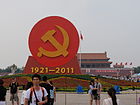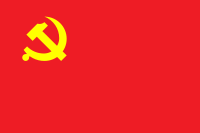
The Communist Party of China (CPC) is the founding and ruling political party of the People's Republic of China (PRC) and the second largest political party in the world. The CPC is the sole governing party within mainland China, permitting only eight other, subordinated parties to co-exist, those making up the United Front. It was founded in 1921, chiefly by Chen Duxiu and Li Dazhao. The party grew quickly, and by 1949 it had driven the Kuomintang (KMT)'s Nationalist Government from mainland China to Taiwan after the Chinese Civil War, leading to the establishment of the People's Republic of China. It also controls the country's armed forces, the People's Liberation Army.

The State Flag of the Union of Soviet Socialist Republics, commonly known as the Soviet flag, was the official national flag of the Union of Soviet Socialist Republics (USSR) from 1922 to 1991. The flag's design and symbolism are derived from several sources, but emerged during the Russian Revolution. The flag is also an international symbol of the communist movement as a whole. The nicknames for the flag were The Hammer and Sickle and The Red Banner.

The flag of North Korea, also known as the Ramhongsaek Konghwagukgi, consists of a central red panel, bordered both above and below by a narrow white stripe and a broad blue stripe. The central red panel bears a five-pointed red star within a white circle near the hoist. The flag is banned from public use in South Korea due to its association with the ruling North Korean regime, although some exceptions for the usage of the flag exist.
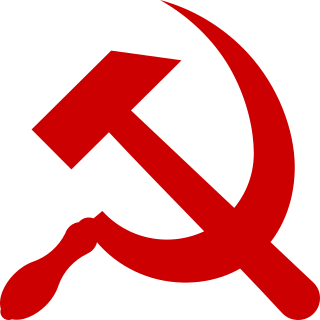
The hammer and sickle is a symbol meant to represent proletarian solidarity – a union between the peasantry and working-class. It was first adapted during the Russian Revolution, the hammer representing the workers and the sickle representing the peasants.

In politics, a red flag is predominantly a symbol of socialism, communism, Marxism, trade unions, left-wing politics, and historically of anarchism; it has been associated with left-wing politics since the French Revolution (1789–1799).

The national flag of Angola came into use when Angola gained independence on November 11, 1975. It is split horizontally into an upper red half and a lower black half with an emblem resting at the center. It features a yellow half gear wheel crossed by a machete and crowned with a star.

The flag of Belarus is a red-and-green flag with a white-and-red ornament pattern placed at the staff (hoist) end. The current design was introduced in 2012 by the State Committee for Standardisation of the Republic of Belarus, and is adapted from a design approved in a referendum in May 1995. It is a modification of the 1951 flag used while the country was a republic of the Soviet Union. Changes made to the Soviet-era flag were the removal of symbols of communism and the reversal of the colours of the ornament pattern, from white-on-red to red-on-white. Since the 1995 referendum, several flags used by Belarusian government officials and agencies have been modelled on this national flag.

The national emblem of Belarus, which replaced the historic Pahonia arms in a 1995 referendum, features a ribbon in the colors of the national flag, a map of Belarus, wheat ears and a red star. It is sometimes referred to as the coat of arms of Belarus. The emblem is an allusion to one that was used by the Byelorussian SSR, designed by Ivan Dubasov in 1950, with the biggest change being a replacement of the Communist hammer and sickle with an outline map of Belarus.

The current flag of Kazakhstan or Kazakh (Qazaq) flag was adopted on 4 June 1992, replacing the flag of the Kazakh Soviet Socialist Republic. The flag was designed by Shaken Niyazbekov.
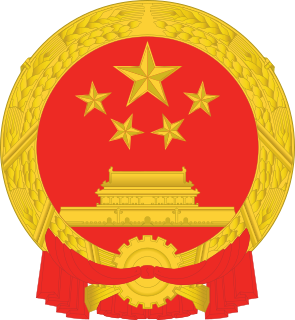
The National Emblem of the People's Republic of China contains in a red circle a representation of Tiananmen Gate, the entrance gate to the Forbidden City, where Mao declared the foundation of the People's Republic of China (PRC) in 1949. Above this representation are the five stars found on the national flag. The largest star represents the Communist Party of China, while the four smaller stars represent the four social classes as defined in Maoism. The emblem is described as being "composed of patterns of the national flag":
...The red color of the flag symbolizes revolution and the yellow color of the stars the golden brilliant rays radiating from the vast red land. The design of four smaller stars surrounding a bigger one signifies the unity of the Chinese people under the leadership of the Communist Party of China (CPC)
—China Yearbook 2004

The flag of the Turkmen Soviet Socialist Republic was adopted by the Turkmen SSR on August 1, 1953. Although similar to the Flag of the Soviet Union, the layout is identical to the flag of the Kirghiz SSR with a ratio of 1:2. The two blue stripes between the red represents the rivers Amu Darya and Syr Darya, the red represents the "revolutionary struggle of the working masses", the hammer and sickle represents the peasants' and workers' union, and the red star is the symbol of the ruling Communist Party.
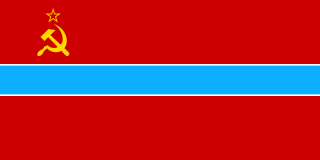
The flag of the Uzbek SSR was adopted by the Uzbek SSR on 29 August 1952. The red represents the "revolutionary struggle of the working masses", the hammer and sickle represents the peasants' and workers' union, and the red star is the symbol of the communist party. There is no official explanation for the symbolic meanings of other elements. However, in some material the white stripes represent cotton, the blue band represents Amu Darya and irrigation in general.

A red star, five-pointed and filled, is an important symbol that has often historically been associated with communist ideology, particularly in combination with the hammer and sickle, but is also used as a purely socialist symbol in the 21st century. It has been widely used in flags, state emblems, monuments, ornaments, and logos. Red Star is also Alexander Bogdanov's 1908 science fiction novel about a communist society on Mars.

The Blue Sky with a White Sun serves as the design for the party flag and emblem of the Kuomintang (KMT), the canton of the flag of the Republic of China (Taiwan), the national emblem of the Republic of China, and as the naval jack of the ROC Navy.

The Flag of Udmurtia is one of the official state symbols of Udmurtia. The proportion of width and length of the flag is 1:2. It is a rectangular three-color cloth consisting of vertical equal stripes of black, white and red with an eight-pointed red cross. The black colour in the flag is a symbol of the earth and stability, red means the sun and life and white means a space and moral purity. The designer of the flag of the Udmurt Republic was Y. Lobanov. The appropriate law N26-РЗ "On the National Flag of the Udmurt Republic" appeared on April 30, 2002.

The coat of arms of the Moldavian Soviet Socialist Republic was adopted on February 10, 1941 by the government of the Moldavian Soviet Socialist Republic. The coat of arms is based on the coat of arms of the Soviet Union. It shows symbols of agriculture, an outer rim featuring wheat, corn, grapes and clover. The red banner bears the Soviet Union state motto in both the Russian and Moldovan languages. In Moldovan, it was initially "Пролетарь дин тоате цэриле, униць-вэ!", then, from the 1950s "Пролетарь дин тоате цэриле, уници-вэ!", both transliterated as "Proletari din toate țările, uniți-vă!". The acronym "MSSR" is shown only in Moldovan ("РССМ").

The coat of arms of the Ukrainian Soviet Socialist Republic was adopted on March 14, 1919 by the government of the Ukrainian Soviet Socialist Republic and subsequently modified on November 7, 1928, January 30, 1937 and November 21, 1949. The coat of arms from 1949 is based on the coat of arms of the Soviet Union and features the hammer and sickle, the red star, a sunrise and stalks of wheat on its outer rims. The rising sun stands for the future of the Soviet Ukrainian nation, the star as well as the hammer and sickle for communism and the "world-wide socialist community of states".

The flag of China, officially the National Flag of the People's Republic of China and also known as the Five-starred Red Flag, is a Chinese red field charged in the canton with five golden stars. The design features one large star, with four smaller stars in a semicircle set off towards the fly. The red represents the Chinese Communist Revolution and the five stars and their relationships to each other represent the unity of the Chinese people under the leadership of the Communist Party of China (CPC). The first flag was hoisted by the People's Liberation Army (PLA) on a pole overlooking Beijing's Tiananmen Square on 1 October 1949, at a ceremony announcing the establishment of the People's Republic of China.

The Young Pioneers of China is a mass youth organization for children aged six to fourteen in the People's Republic of China. The Young Pioneers of China is run by the Communist Youth League, an organization of older youth that comes under the Communist Party of China. The Young Pioneers of China is similar to Pioneer Movements that exist or existed in many Communist countries around the world.
Communist symbolism represents a variety of themes, including revolution, the proletariat, peasantry, agriculture, or international solidarity.



